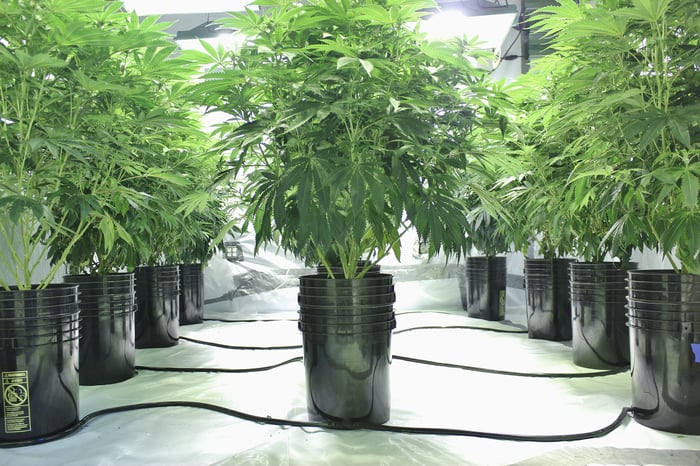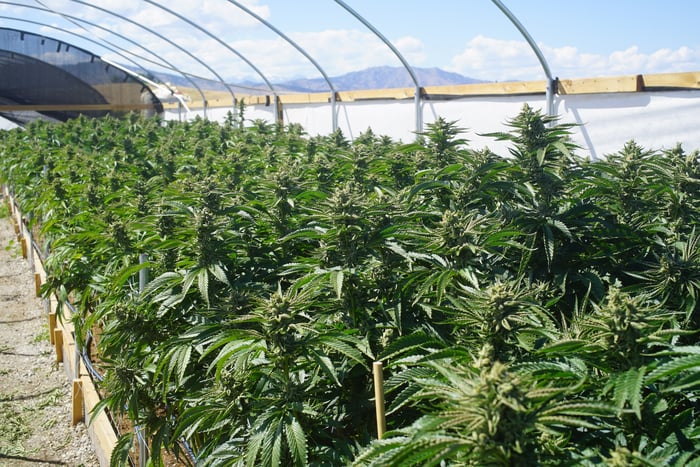The marijuana industry has come a mighty long way in a very short amount of time. If we look back to 2005, Gallup notes that just a third of all Americans it surveyed wanted to see cannabis legalized in the United States. By 2010, even with favorability toward weed improving, not a single state had given pot the green light at the recreational level. Now, in 2019, marijuana is legal medically in 33 U.S. states, 10 of which also allow adults to consume it, and 2 out of 3 Americans are in favor of its legalization.
To our north, pot became legal for recreational use in October. Being the first industrialized country in the world to green-light cannabis, Canada has single-handedly validated the marijuana industry as a legitimate business model. Expected growth for the global pot industry could easily near 30% on a compounded annual basis through 2022 as new countries or states legalize, and already legal countries and states experience increased demand.

IMAGE SOURCE: GETTY IMAGES.
But even this seemingly perfect scenario isn’t without potential pitfalls. Supply shortages have constrained the Canadian cannabis industry, while a lack of financing options and a less-than-accommodating federal government in the U.S. have put a lid on the U.S. state-level sales. If the Jenga blocks came tumbling down, pure-play stocks could be crushed.
The solution? Investors should consider buying into companies that offer a reasonable amount of high-growth marijuana exposure (potentially greater than 10% of total revenue), but also have built-in safety nets that would completely buoy the business if the great cannabis experiment falls flat on its face. Right now there are three North American pot stocks that offer a varied degree of built-in safety nets.
Scotts Miracle-Gro
Arguably the best known of the ancillary stocks is Scotts Miracle-Gro (NYSE:SMG). You’re most likely familiar with Scotts as a company that prides itself on making your lawn and garden look great. Aside from improving the look and aesthetic of people’s greenery, Scotts is also responsible for helping enterprises improve crop yields. And in recent years, it’s waded into previously unchartered territory by helping to improve crop yields for cannabis growers.
The company’s subsidiary Hawthorne Gardening primarily provides hydroponic solutions to the medical cannabis industry. Hydroponics involves the growth of plants in a nutrient-rich water solvent as opposed to soil. However, the company also provides soil, nutrients, and lighting solutions to the weed industry.

IMAGE SOURCE: GETTY IMAGES.
Last year, Scotts Miracle-Gro generated $2.11 billion in sales from its U.S. consumer segment. Basically, 80% of its business came from traditional lawn and garden sales and enterprise orders. This is a cyclical business, and it’s dependent on weather trends. But it’s also historically very profitable for the company, providing a healthy fail-safe if the cannabis business struggles.
Then again, Scotts also recorded almost $345 million in sales from Hawthorne, which accounted for 13% of total sales in 2018. This percentage should head higher in 2019 with the acquisition of Sunlight Supply for $450 million, which was completed last year. Sunlight Supply caters to small- and medium-sized cannabis businesses and offers a similar array of hydroponic equipment. Combining the two businesses should yield at least $35 million in cost synergies, as well as improve pricing power. Don’t be surprised if Scotts Miracle-Gro is able to deliver double-digit earnings-per-share growth if Hawthorne contributes roughly a fifth of total sales.
Village Farms International
When all is said and done, British Columbia-based Village Farms International(NASDAQOTH:VFFIF) may have more direct exposure to the marijuana industry than either of the other two stocks mentioned here. That’s because it entered into a joint venture in 2017 with Emerald Health Therapeutics (NASDAQOTH:EMHTF) to retrofit 1.1 million square feet of existing vegetable-growing greenhouses to cannabis production.
Emerald Health Therapeutics and Village Farms International coming together to create the Pure Sunfarms brand made a lot of strategic sense. For Emerald Health, it has keen knowledge of the cannabis industry, and it needed a pathway to expedite getting marijuana to market. Partnering with a company that already had constructed greenhouses saves on cost and time. As for Village Farms, it gains access to a considerably faster-growing crop than, say, tomatoes or cucumbers.

IMAGE SOURCE: GETTY IMAGES.
Where investors’ built-in safety net comes into play is with Village Farms’ traditional vegetable-growing business. Though it’s not very exciting and margins can be dependent on product demand, Village Farms still generated $111.2 million in sales from its traditional operations through the first nine months of 2018. Even with its portion of expenditures, the company managed $1.4 million in consolidation EBITDA (earnings before interest, taxes, depreciation, and amortization).
Recently, Village Farms announced its intention to uplist from the over-the-counter exchange to the Nasdaq. The company and Emerald Health also informed investors that 825,000 square feet of the ongoing retrofit at the Delta-3 greenhouse has been licensed by Health Canada. With full licensing expected in 2019, the duo expects to produce at least 75,000 kilograms annually at peak production.
Shopify
A third stock that could see significant benefits from the marijuana industry, but that has a safety net built into its business model, is Shopify (NYSE:SHOP).
Shopify’s leading e-commerce platform has been a popular choice for Canadian cannabis retailers in the early going. The company’s online platform is being used by the Ontario Liquor Control Board in all facets of sales (online, mobile, and brick-and-mortar), and it landed a contract with British Columbia this past June to act as a middleman between private retailers and growers. Since this has predominantly been a cash-dominated industry, not a lot is known about consumers’ true demand or product desires. Shopify’s e-commerce platform is going to empower retailers to better understand their customers, and help growers and retailers figure out where that demand fulcrum lies.

IMAGE SOURCE: GETTY IMAGES.
But the thing about Shopify is that it doesn’t need the marijuana industry to thrive. It’s been growing at a lightning-quick pace for years, and will continue to do so with or without cannabis. In the third quarter, Shopify delivered 58% sales growth to about $270 million, with merchant solutions packing the biggest revenue punch.
The other factor here is that we don’t exactly know what percentage of sales marijuana is responsible for since Shopify’s management team hasn’t broken that figure out from aggregate revenue. We do know its online software was handling more than 100 orders per minute on the day legalization kicked off in Canada (Oct. 17), and I’d presume it’s remained just as successful as supply continues to trickle upward. Hopefully, we’ll get more clarity on total sales from cannabis in a future report — but yours truly believes it could eventually account for 10% to 15% of the company’s total revenue.
More at: Fool.com







very nice put up, i certainly love this web site, keep on it